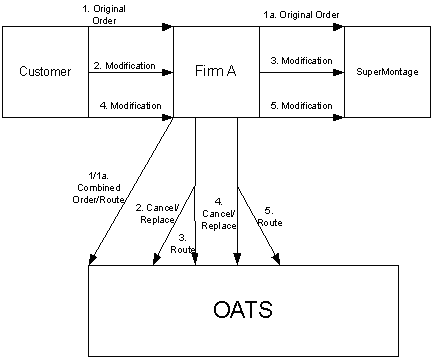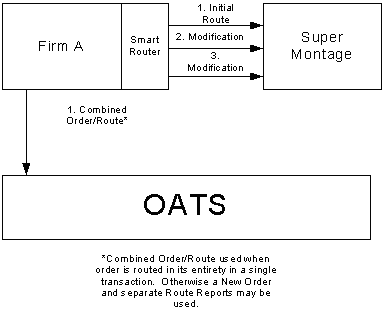OATS Report - NASD Provides Additional Guidance on OATS Reporting Obligations for Orders Routed to SuperMontage 5/31/05
May 31, 2005
NASDAQ has recently enhanced the SuperMontage order modification process to allow for, among other things, the price of an order to be changed without having to cancel the original order and submit a new order.1 This enhanced order modification process impacts members' OATS obligations when reporting order modifications for orders that have been routed to SuperMontage. In light of these SuperMontage changes and the related OATS reporting impacts, NASD is issuing this OATS Report to inform members of the proper OATS reporting of modifications to orders previously routed to SuperMontage. Members should note that OATS reporting requirements are different for order modifications that are initiated by a customer versus modifications that are initiated by a member's intelligent order routing system. Outlined below are the OATS reporting requirements for order modifications in each of these scenarios.
Customer Initiated Order Modifications
When a customer modifies an existing order, OATS Rules require firms to submit a Cancel/Replace report to reflect the modification. If the order being modified had previously been routed to SuperMontage, the member also must update the SuperMontage order to reflect the new terms and conditions of the order. When the member updates the SuperMontage order, a new Route Report must be submitted to OATS. As stated above, SuperMontage now provides the ability to modify a broader range of terms and conditions, including price, on an existing SuperMontage order. Because SuperMontage no longer creates a new record for most order modifications, the original routed order id entered into SuperMontage by the member for the original order is maintained by SuperMontage for all subsequent modifications. Accordingly, when a member generates a Route Report to SuperMontage for the Cancel/Replace event from the customer, the member must use the same routed order id that was entered into SuperMontage for the original new order to ensure OATS can match the subsequent Route Report to the related SuperMontage order modification.
Example:
Firm A receives a customer order to buy 200 shares of PDQQ at $30. Firm A routes the order to SuperMontage. The customer then modifies the order twice, once to change the price to $29.95 and once to change the quantity to 250 shares. After each modification Firm A sends the order back to SuperMontage. In this scenario the firm must report to OATS as follows:
- Combined Order/Route to SuMo for 200 shares @ $30
Routed Order ID ABC123 - Cancel/Replace modifying price to $29.95
- Route to SuMo-Routed Order ID ABC123
- Cancel/Replace modifying shares quantity to 250
- Route to SuMo- Routed Order ID ABC123
The diagram below further reflects the firm's OATS reporting responsibilities for the above scenario of customer directed modifications to orders routed to SuperMontage.

Diagram Explanation of Events
- Firm A's original receipt of the customer order and the routing of that order in its entirety to SuperMontage. An OATS Combined Order/Route Report represents these events.
- Customer's modification to the order, which is represented in OATS by a Cancel/Replace Report.
- Firm A's subsequent route of the order to SuperMontage. An OATS Route Report represents this event.
- Customer's second modification to the order, which is represented in OATS by a second Cancel/Replace Report.
- Firm A's third route of the order to SuperMontage. An OATS Route Report represents this event.
System Initiated Order Modifications
The March 3, 2003 OATS Report article entitled Firm Responsibilities When Using "Intelligent Order Routing Systems" provided guidance on OATS reporting requirements when using intelligent order routing systems.2 The guidance in the March 3, 2003 OATS Report applied to a variety of scenarios involving the use of smart routers, not just orders routed to SuperMontage. The reporting guidance being issued today in this OATS Report, however, applies only to orders routed to SuperMontage, and supercedes the previous guidance regarding orders routed to SuperMontage. Specifically, the guidance provided in the March 3, 2003 OATS Report, directing members to report to OATS all order modifications generated by intelligent order routing systems that were routed to SuperMontage because SuperMontage did not capture the modifications in such a way that allowed NASD to link the original order to the related modifications, is superceded. The recent changes to the SuperMontage order modification process now allows for most order modifications to be made such that the original order number is retained and linked to the subsequent modifications, thereby enabling OATS to link the events together. As a result, going forward, modifications made to orders routed to SuperMontage that are originated by intelligent order routing systems do not require the submission of a Cancel/Replace or any subsequent Route Reports to OATS. Members should therefore only report the initial Route to SuperMontage.
As stated above, all other guidance regarding the use of smart routers contained in the March 2003 OATS Report remains unchanged. Nothing in this OATS Report is intended to change the guidance previously provided for order modifications to orders routed by a smart router to market centers other than SuperMontage.
Example:
The diagram below reflects a firm's responsibilities when using a "smart router" to send an order to SuperMontage. Firm A receives a limit order to buy 5,000 shares of PDQQ at $24. Firm A's intelligent routing system routes the order to SuperMontage with a limit price within a certain percentage of the inside market. Firm A's system changes the limit price each time the inside market changes and sends it back to SuperMontage. After a few modifications, the order is executed.
Firm A is only required to report the receipt of the order from the customer and its initial route to SuperMontage. Each modification of the order and is tracked through SuperMontage. The following OATS reporting would be required:
Firm A
Combined Order/Route Buy 5,000 shares at $24 Destination Code "U" for SuperMontage

Diagram Explanation of Events
- Firm's receipt and system generated route of the order to SuperMontage. An OATS Combined Order/Route represents this event.
- System generated modification to the order. Since the system generates the modification, no OATS Report is necessary.
- System generated modification to the order. Since the system generates the modification, no OATS Report is necessary.
Should you have any questions regarding this notice or on OATS in general, please contact the OATS Help Desk at 1-800-321-NASD.
1 Prior to these recent changes, SuperMontage only allowed for modifications to an existing order in a limited number of circumstances. Material changes to the terms and conditions of an order, such as price, required the cancellation of the original order and entry of a new, separate and distinct order.
2 The March 3, 2003 OATS Report stated that for order modifications generated by an intelligent order routing system, members did not have to report to OATS these system generated modifications if the venue to which the order was routed reported the modifications to OATS. This is because NASD could obtain information regarding the modifications from the routing destination's OATS reports. Orders and related modifications, however, routed to a venue that does not have OATS reporting obligations, such as a non-member exchange, must be reported to OATS since NASD cannot obtain the information from the routing destination. At the time the OATS Report was published, SuperMontage did not capture order modifications in such a way that allowed NASD to accurately link the events. Members were therefore instructed that all order modifications routed to SuperMontage also had to be reported to OATS, whether they were generated by an intelligent order routing system or by a customer.
